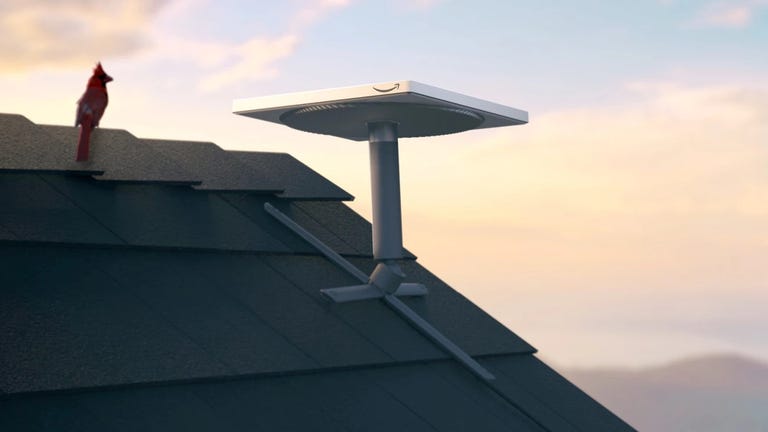What’s the latest news on Amazon’s Internet Service, Project Kuiper?
It’s amazing how you can bring broadband to remote, rural and remote areas. Laying fiber-optic cables is an expensive, capital-intensive process. Cable Internet performance is declining, however 5G home network increasingly, speed and reliability are at the mercy of tower proximity and network congestion. DSL is next to useless.
This story is part of Crossing the broadband divideCNET coverage of how the country is working to make internet access universal.
The solution, perhaps: satellite internet. It’s not the single, geostationary satellite services from Hughesnet and Viasat that have been around for years with few upgrades, but an entire fleet of high-tech, low-cost satellites.
Starlink has demonstrated that, in numbers (as in thousands), satellites in Earth orbit or LEO can provide extensive coverage while lowering latency, increasing speed capabilities and eliminating restrictive data constraints. of conventional satellite networks.
The challenge is to pull off such a big project. Amazon received FCC approval in July 2020 to deploy and operate Project Kuiper (ki — as in kite — per) satellites. Since then, the tech and e-commerce giant has been busy building its online business, but it still has a way to go before it’s ready. for home use. Here’s what you need to know about Project Kuiper as of August 2024.
What is Project Kuiper?
Project Kuiper is Amazon’s effort to increase internet access around the world by sending thousands of low-orbit satellites that will send and receive internet signals around the world. The service is designed for residential and commercial applications, providing high-speed connectivity for use in homes, businesses, government agencies and other institutions, especially in remote areas.
That sounds a lot like Starlink, and I’d say it’s similar at least in intent and delivery. The technology and the resulting capabilities are different.
In addition to the thousands of advanced LEO satellites, about 6,000 orbiting somewhere between 367 and 391 kilometers in the air, Project Kuiper will use a network of ground-based antennas , fiber connections and customer stations to provide services.

Amazon says that a standard customer base, which you can use to get fixed home service, has the potential to provide speeds of up to 400 megabits per second. That’s a good deal faster than the current speed expectations from Starlink (25 to 100Mbps on a standard service), and the equipment may come at a lower price despite Starlink reducing its charging fee. shop at select locations. Business terminals boast even faster speeds, up to 1 gigabit per second.
It makes perfect sense. When can I register? Not for another year or so, at least.
When will the Project Kuiper Network be available?
According to an Amazon spokesperson, production of the satellite continues at Amazon’s manufacturing facility in Kirkland, Washington. The first launch of production satellites is planned for Q4 2024, and the company intends to “rapidly increase the launch speed after that first mission.”
Once several hundred satellites are in orbit, the ability to broadcast broadband does not take long. “We plan to launch the commercial service of Project Kuiper next year [2025]starting with service demonstrations for our first enterprise customers, followed by customer beta testing and general availability later in the year.
So, Project Kuiper home service could arrive anytime by the end of 2025. Don’t plan to cancel your internet service just yet. Not everyone across the US will be eligible to enroll right away.
Location availability will vary
The Project Kuiper satellite will operate within 56° north and south of the Equator. That includes most of North America (but not including most of Alaska), and almost all of South America, as well as much of Africa, Australia, Asia and Europe.
Not all planned locations will be serviced immediately upon launch. Amazon has not revealed which locations will be the first to qualify, but said that “locations will come online as we add satellites to the constellation.”
So far, so good for Project Kuiper

Amazon has successfully launched the first test satellites for its Project Kuiper broadband satellite network.
Project Kuiper launched two prototype satellites in October 2023, and, after 30 days, it was reported to have achieved a 100% success rate. The satellites were later decommissioned from orbit in May 2024 as part of Project Kuiper’s commitment to space safety and security.
By December 2023, Project Kuiper received 80 rockets from four launch providers: Arianespace, SpaceX (yes, Starlink’s parent company), ULA and, of course, Jeff Bezos-founded Blue Origin . Rocket prices and FCC approval for satellite launches and Project Kuiper operations to begin providing broadband for commercial and residential use sometime in 2025.
CNET will keep you updated with important updates, including when Amazon’s Project Kuiper internet will be available for residential use in the US, what speeds you can expect and how much it will cost.
#Whats #latest #news #Amazons #Internet #Service #Project #Kuiper
